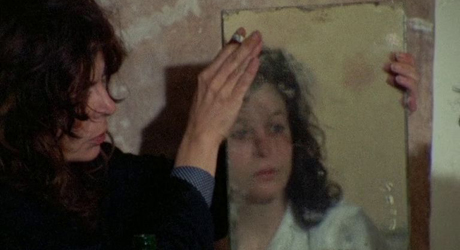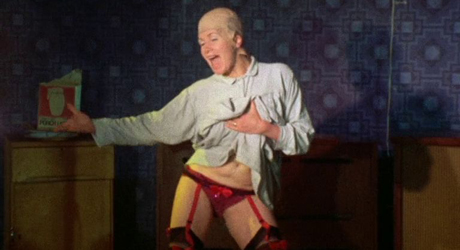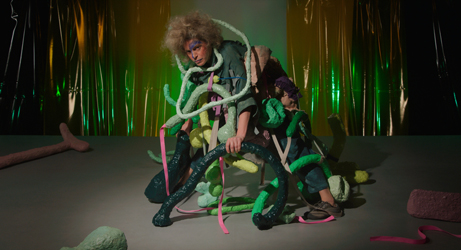
Made in 1972, Jane Arden’s The Other Side of Underneath was the only British film of the decade to be solo-directed by a woman. A boldly feminist film in its engagement with, and rejection of, the contemporary place of women in British society, the film is also unique for its take on mental illness. Arden’s film begins with an unnamed woman (Susanka Fraey) who is pulled from a lake. Half-drowned, she is put in an ambulance and rushed to a psychiatric hospital in the Welsh countryside, where she is labeled as “schizophrenic.” There, she encounters fellow patients and a therapist (played by Arden herself), and goes through a series of surreal tableaux that reflect the mental states of the women around her. In playing with doctor-patient relations, the causes and effects of mental distress, and the concept of healing, The Other Side of Underneath redefines what it means to be “sick.”
Arden’s film owes its anger to the feminist movement as much as to the then-popular anti-psychiatry movement. Gaining momentum in the 1960s, anti-psychiatry challenged the idea of mental illness and its stigma, while also opposing harmful treatment methods (like electroconvulsive therapy and lobotomy) and championing new ways of coming to terms with disorders. Published in 1960, psychiatrist R. D. Laing’s The Divided Self: An Existential Study in Sanity and Madness became a germinal text for the movement in its analysis of psychosis and schizophrenia as stemming from the titular divided self: an individual’s true personality versus the one they create in order to appear socially acceptable.
In Laing’s text, he recounts the stories of a number of patients, but those involving women focus on the struggle with their identities. They conflict with the relationships in their lives, but there is no acknowledgment of the complex place women take up in the world beyond shallow family bonds. Despite its attempts to challenge mental healthcare and our perception of illness, anti-psychiatry maintained a patriarchal structure. No women in the movement achieved the stature of Laing and his contemporaries, and there was a lack of understanding of women’s experiences outside of masculine perception. In attempting to understand mental illness, Laing and others became expert interpreters, speaking for the patients they had analyzed, re-establishing the doctor-patient power structure as well as the patriarchal male doctor-female patient structure. [i] In The Other Side of Underneath, we find a filmic version of Laing’s concepts paired with a gendered analysis to create a feminist anti-psychiatry, one which seeks to understand the source of mental illness without reducing it to a solely reactive experience.
Once Arden’s protagonist is brought to the hospital, she experiences a series of divides in her personhood. Initially, she is out of touch with her surroundings and near catatonic. She lies dazedly on a bed while another patient, Meg the Peg (Sheila Allen) torments her, in a sequence that culminates with Meg and her companion alternately screeching, “She’s pretty,” and “She’s got a pointless mind.” The idea that a woman’s image impacts her social role is later reprised by another patient, who tells her therapist that she does not like her own face. Holding a cast of the woman’s face, the therapist smashes it. In these moments, Arden clearly lays out the conflict of women and their role as Beauty Object—how this role can subsume a woman’s identity; how an inability to conform to it can lead to self-hatred and destruction.
This anxiety over an image identity, which one fears and hates, or which is incompatible with one’s inner psychology, also relates to historical conceptions of women’s mental illness. In an antiquated hospital and with all the patients dressed in Victorian nightgowns, Arden’s film is both of its time and deeply bonded to the past. In Victorian England’s psychiatric hospitals, great emphasis was placed upon “moral insanity,” comprising of feelings, habits, and lifestyles that went against social conventions. In an attempt to create acceptable Victorian citizens, insanity could be cured by “moral management,” which involved encouraging respectability by “subtly press[ing patients] towards a cultural norm.”[ii] Whereas male patients were encouraged to work and exercise, women’s sanity hinged upon social decorum. A key to this was appearance. Neglect of dress and hair was seen as a symptom of “insanity,” as it was supposedly in a woman’s nature to care about looks. This mentality continued into the twentieth century, where the use of make-up or frequenting beauty parlours, was seen as healthy behaviour for women and a sign of feminine sanity. We see this mentality reflected in Arden’s film, where being ill hinges upon a disconnect in image. Psychological complexity clashes with objectified appearance, and a confrontation with one’s image devolves into destructive chaos. Faced with a conflict of visual identity, which does not give space beyond strict gendered roles, the patients in Arden’s hospital become frenzied.
A second divide arises when the protagonist is married. Dressed as a bride, she appears with her groom in a cemetery before being interred into the ground. The divide depicted here comes from the incoherence of love and domestic life, and the “death” that these experiences represent for women. In the 1950s and 1960s, British housewives were interviewed on their experiences with mental illness by the National Housewives’ Register. After analyzing these accounts, Ali Haggett noted that the majority of the women involved attributed their mental illness to marital discord.[iii] This often came in the form of neglect, infidelity, and general conflict. All of these may have carried a gendered dimension but it was life within the marriage, rather than dissatisfaction with the role of housewife, that most impacted respondents. Rather than demonstrating that the role of the housewife is itself inherently unfulfilling, these accounts exhibit a group of women who enjoy their position in society, while experiencing strong emotional and mental reactions to life within the domestic sphere. Arden, in her depiction of marriage as death, does not deny the appeal of or desire for traditional gender roles, but shows us the conflict of a woman willingly consenting to marriage while simultaneously dealing with its negative impacts.
A common theme in these divides is violence and self-destruction. Describing delusional disorders, Laing wrote:
It is not uncommon for depersonalized patients, whether or not they are schizophrenic, to speak of having murdered their selves and also of having lost or been robbed of their selves. Such statements are usually called delusions, but if they are delusions, they are delusions which contain existential truth.[iv]
Faced with a divide in self, Laing’s conception of depersonalization has the patient attempting to terminate one persona in order to give complete control to the other. This becomes a constant within The Other Side of Underneath: it can be seen in the protagonist’s desire to enter into marriage despite it being a death sentence. Later, it can be seen when the protagonist smashes a cast of her face with a mallet and goes on to bludgeon a fellow patient. The two become indistinguishable with their damp hair and matching nightgowns, distorted by a constantly moving camera. Repeatedly, patients conclude their scenes with violence, usually directed at some form of themselves. But where Laing considered destruction and self-destruction apolitically, Arden situates the existential crisis in gendered terms with the divides tied to a gendered social reality.

While the protagonist is trapped within crisis, Arden provides a vision of life beyond these gendered divides. In one scene, Meg the Peg stands on stage in her Victorian nightgown. She shrieks, “Underneath me nightie, guess who I am?” She then pulls up the dress to reveal pink lingerie as she proclaims, “It’s your castrating mum!” She goes on with her performance, dancing in her underwear, taking a cane and miming the masturbation of a penis, saying “You don’t frighten me with your little wee wee, I could bite him off.” She embraces her performance, showing a freedom and joy unexperienced by the rest of the hospital, and in this pleasure, she embraces being a cause for Freudian castration anxiety. This is somewhat dated today: Arden’s attack on a sexist, cis-centric psychoanalytic theory is to idealize it, rather than dismantle it. Meg, in being defined by the lack of a penis and the threat of castration, revels in the fear she generates and basks in her own power. Discarding her hospital uniform and embracing a misogynistic psychoanalytic stereotype, Meg the Peg does not fracture and implode existentially like other patients before her.
Stylistically, this scene reflects a mental clarity despite its chaos. Meg leans into the theatrics of her performance, which is characterized by incoherence. She switches from English to German and French, grabs and discards random props for no reason and changes her song’s tempo at will. In the name of defying psychiatric condemnation, Arden situates her filming within a framework that rebukes “sanity.” Throughout the film, the women’s mental states are depicted with a fervour that matches their destructive behaviour. The camera roves deliriously across the incomprehensibly surreal geography of the hospital, as an expressive soundtrack slips in and out of diegesis. By employing an experimental style, Arden rejects a classical form of filmmaking, impressionistically representing the experiences of the women she depicts. But this form is capable of tonal variety. The stylistic chaos can express fear and distress or it can express joy and liberty, as in the case of Meg’s performance. Positing illness as universal rather than marginalized, Arden focuses on how women patients may come to a form of mental illness that is specific to women.

The protagonist eventually stumbles out the institution’s door. Free from the hospital, she and her fellow patients appear outside. The women have shucked their nightgowns and donned loose white robes. They take up instruments and begin to play, swaying slowly as if in a trance. As the music intensifies, the protagonist rises from the soil and begins dancing more and more wildly, becoming the centre of the ritual.
Within the rigid structures of the hospital, like in uninstitutionalized society-at-large, the patients are confined to strict roles, compounded by gender. Where the women of the hospitals are subordinate to gendered roles in society, as patients they are also subordinate to the doctors, and as sick, to the healthy. Pushed into the categories of woman, patient, and sick, the hospital’s inhabitants rebel with violent intensity, attacking themselves and each other while experiencing great psychological distress. This is in stark contrast to Meg the Peg, who embraces a mental chaos and rejects gendered values. It is only once the patients collectively depart from both the institution and the therapist that they begin to heal. Like Meg the Peg, they too begin to embrace an unconventional social reality. According to Laing (using some problematic language), “I am aware that the man who is said to be deluded may be in his delusion telling me the truth, and this in no equivocal or metaphorical sense, but quite literally, and that the cracked mind of the schizophrenic may let in light which does not enter the intact minds of many sane people whose minds are closed.”[v]





